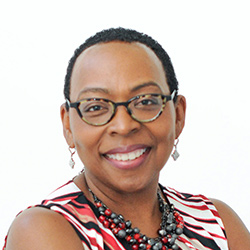By Adrienne Ruffin
LTSS Center researchers can’t do their jobs without critical, behind-the-scenes work from non-researchers.
I stand out a bit in the Washington, DC office of the LeadingAge LTSS Center @UMass Boston, mostly because I work behind the scenes.
I don’t spend my days analyzing trends in the field of aging services like my research colleagues do. I don’t make site visits to providers of aging services. I don’t conduct focus groups with nurses or direct care workers, or share research findings with legislative committees.
But despite all those “don’ts,” I like to think that the work I do makes all those research activities possible.
I’m the one who keeps track of the research that my colleagues conduct. I make sure our research contracts are executed in a timely manner, and that we fulfill all of our commitments to funders.
I’ve always loved my work, because I knew it was contributing to creating a better world in which to age. That love grew exponentially over the past year when I stepped out from behind my computer screen and led LeadingAge’s National Member Survey initiative.
From the start of our survey planning process, I knew it was important to bring together a cross-functional team to support the “operational thinking” needed to help us build a solid, nimble organizational infrastructure that will allow LeadingAge to create a centralized knowledge function that captures periodic, real-time information about our members.
I didn’t survey even one LeadingAge member during the 4-month survey process. But in my new role as vice president of LTSS Center Strategic Initiatives, I was instrumental in laying the groundwork that is now allowing LTSS Center researchers to analyze the responses that members submitted to us from May through August 2019.
Those 4 months—and the months of planning that preceded them—gave me a new appreciation for the critical, behind-the-scenes work that goes into executing an organization-wide initiative that will benefit our national office, state partners, and members.
STEPS IN REACHING THE SURVEY GOAL
LeadingAge’s overall goal for the Member Survey initiative was simple, but challenging: to achieve the highest response rate possible so our researchers would have enough data to draw reliable conclusions about the LeadingAge membership—conclusions about who members are serving, what services they are offering, and the characteristics of their workforce.
If I was going to help LeadingAge meet that challenge, I knew I needed a diverse team of people representing every facet of our organization. In addition to LTSS Center researchers, that included key people from data services, membership and state relations, communications and marketing, finance, technology & business solutions, the Center for Aging Services Technologies, and business development. That team needed to successfully complete 5 steps:
- Update the contact information on file for each LeadingAge member. This wasn’t as easy as it sounds, since we were asking members to complete one survey for each of their service lines. We knew we would get the most accurate results if we sent those surveys to the people who managed each service line in each member community, and not necessarily from the main contact person we have on file. That meant calling our members and asking for the names and contact information for each of their service line managers.
- Educate members about the value of the survey and the benefit of completing it. We knew that providers of aging services suffer from “survey burnout” due to the large number of surveys that come across their desks. How could LeadingAge stand out in the crowd so our busy members would take time to help us out? We designed a variety of marketing tools and offered various incentives. But we knew we needed a “secret weapon” to ensure the response we needed.
- Enlist lots of partners. Our “secret weapon” was our cadre of partner organizations operating in 38 states. Nine of those state executives agreed to join a State Partner Member Survey Task Force that helped us plan our survey outreach. In collaboration with this task force, we designed outreach to each of the state partners and sponsored a national contest—with some very attractive prizes—to energize state teams who in turn energized the members. It worked!
- Celebrate. Most important, we made sure to say “thank you” to everyone who helped. We had tremendous support from the national office leadership and staff, our state partners and their staff, and of course, the members who completed surveys.
- Encourage improvements. After the survey period closed, key leaders on the planning team identified significant learnings from this year’s survey and how to use those learnings to strengthen our survey infrastructure. The State Partner Member Survey Taskforce also provided key feedback on ways to improve the process from a state perspective.
LOOKING BACK ON A JOB WELL DONE
The LeadingAge Member Survey process turned out to be an exciting ride for this desk jockey. I stepped out of my comfort zone, which was not easy but was, in the end, extremely gratifying. The survey process helped build my confidence, hone my team-building skills, and forge strong relationships with co-workers and state partners.
The 37% response rate—the highest for any LeadingAge survey—was just icing on the cake.
As my research colleagues now analyze the data and prepare to release their final report on the survey findings, I’m feeling proud of myself and our entire team for using hard work, determination, collaboration, and a healthy measure of humor, to deliver the raw material that the researchers needed to do their jobs.
It takes a village to conduct an initiative like the LeadingAge Member Survey. Our researchers couldn’t have done their jobs without the non-researchers on our team. That’s a lesson that we all learned, and one that all of us—researchers and non-researchers alike—need to remember.

Adrienne Powell Ruffin, DSL, is vice president, LTSS Center strategic initiatives, in the Washington, DC office of the LeadingAge LTSS Center @UMass Boston. Read more about Adrienne
